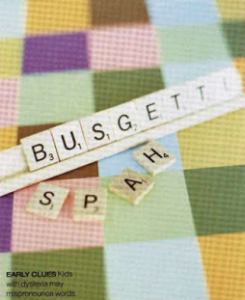
Detecting Dyslexia
New studies show that early intervention helps kids overcome dyslexia. Yet many schools are slow to test for this common reading disability. Parents can ensure their children get the help they need by being alert to the warning signs.
READ FULL ARTICLE BELOW
Rummaging through the overflowing bookcase in her room one evening, Michelle chose the book she wanted her mother to read as part of their nightly bedtime ritual. It seemed like an ordinary choice. So Beth Wallace sat down with her then 7-year-old and read Thank You, Mr. Falker by Patricia Polacco, the story of a young girl named Trisha whose friends think she’s dumb because she’s having trouble learning to read. Trisha’s life changes when her teacher, Mr. Falker, offers to help her after school. When the book was over, Michelle turned to her mother with tearful eyes and asked, “Why can’t someone help me to read?”
Although Wallace now realizes there had been several earlier signs pointing to dyslexia – in kindergarten Michelle wrote the letters of her name in a different order each time, and in first grade she couldn’t identify short common words – it took until that evening for the Tallahassee, FL, mom to recognize that there was indeed a problem and something had to be done about it.
 In the U.S., 15 to 20 percent of people have a reading disability and, of those, 85 percent have dyslexia, according to the International Dyslexia Association in Baltimore. Simply put, dyslexia is a language-based disorder that affects reading and writing. Research shows that it’s caused by varying degrees of faulty wiring in the brain. Instead of realizing that the word bat is made up of three units of speech, or phonemes – b, aaaa, and t – a dyslexic hears only one sound. So when it comes to sounding out words – the first step in learning to read – a child like Michelle faces an uphill battle.
In the U.S., 15 to 20 percent of people have a reading disability and, of those, 85 percent have dyslexia, according to the International Dyslexia Association in Baltimore. Simply put, dyslexia is a language-based disorder that affects reading and writing. Research shows that it’s caused by varying degrees of faulty wiring in the brain. Instead of realizing that the word bat is made up of three units of speech, or phonemes – b, aaaa, and t – a dyslexic hears only one sound. So when it comes to sounding out words – the first step in learning to read – a child like Michelle faces an uphill battle.
Recent breakthroughs show, however, that the battle can be won if kids receive early help. In fact, new research funded by the National Institute of Child Health and Human Development (NICHD) in Bethesda, MD, reveals that early intervention actually alters pathways in the brain. In other words, “with proper teaching and stimulation, dyslexia may be correctable,” says Sally Shaywitz, M.D., co-director of the Yale Center for the Study of Learning and Attention in new Haven, CT, and author of the acclaimed book Overcoming Dyslexia, who co-led the study. Researchers enrolled 37 struggling readers, ages 6 to 9, in a program that included a focus on phonemic awareness and phonics and compared them to 12 poor readers who received the kinds of intervention typically given at school, such as remedial reading and tutoring. The first group scored significantly higher in reading skills than the second. What’s more, sophisticated imaging technology showed that the brains of the 37 formerly poor readers were working more like the brains of good readers; they showed increased activity in an area that automatically recognizes words.
Why Dyslexia Goes Undetected
Knowing what recent studies have revealed, it seems odd that dyslexic children are still slipping through the cracks. One problem, experts insist, is that not enough attention is being paid to warning signs in the early grades.
“Across-the-board kindergarten screenings would lead to a greater degree of attention to children who are at risk,” says G.Reid Lyon, Ph.D., chief of the child development and behavior branch of the NICHD. So far, 18 states require kindergarten screenings, but they vary widely in what they’re looking for. “Many schools screen for whether kids can name colors or tie their shoes instead of looking for pre-literacy skills, such as recognizing the sounds in words,” says Susan Hall, a former board member of the International Dyslexia Association and author of Straight Talk About Reading, who became an advocate for kids with dyslexia when her son was diagnosed with it in 1995.
Then there are the children who get by when they’re younger, so adults assume there’s no problem. But there are critical points in elementary school when the curriculum shifts, and that’s when a child with dyslexia may slip. “In first grade, kids receive formal reading instruction, and you may see a dyslexic child having difficulty sounding out words and relying more on guessing to get by,” says Dr. Shaywitz. Still, teachers and parents are likely to think this is a temporary setback. By third and fourth grades, however, words are becoming harder to memorize, and kids are no longer learning to read; they’re reading to learn. A dyslexic child who is not receiving scientifically proven reading instruction will slip even further.
Spotting Early Clues
The goal is for educators to clue into key signs at earlier ages. But parents play an important role in making sure their kids get the help they need; in many cases, it’s a parent, rather than the school, who identifies a problem.
By the time your child finishes preschool, ask yourself whether she is able to learn simple rhymes, has trouble recalling the right word to use in a sentence, mispronounces words (like basgetti for spaghetti), or has difficulty learning the names of the letters of the alphabet.
For children in kindergarten through fourth grade, common signs of dyslexia include being unable to associate letters with sounds, skipping over and confusing small words (like at, to, and in), mispronouncing long, unfamiliar words, and having a great fear of reading out loud. While these difficulties don’t mean that your child definitely had dyslexia, experts suggest keeping a close watch and talking to your child’s pediatrician and teacher.
With school-age children, struggles over homework can also be telling. Maria Barton of Larchmont, NY, remembers her frustration with her then first-grade son, Elisha. “By page two he couldn’t remember a word he’d read on page one,” she recalls. In addition, Elisha confused letters and was unable to hold on to vowel sounds. For a while, Barton thought he wasn’t concentrating. Bewildered that her son “just couldn’t get it,” she approached his teacher, who agreed that Elisha’s reading skills were problematic. After doing research herself, Barton had her son privately tested; he turned out to have dyslexia.
You Detect A Problem – Now What? 
Susan Hall, like Barton, also had to take matters into her own hands. When her son Brandon was in first grade, Hall volunteered to come into the class to help with a project. She sat with a group of five children that included her son and listened as each child took turns reading aloud. “This was a turning point for me,” she recalls vividly. “When I saw how Brandon read compared to the other students and how embarrassed he was, I knew something wasn’t right.”
When Hall asked the teacher what could be done to help him, she replied that it was just a “developmental lag” and that “he’ll catch up.” A few months later, Hall complained again about her son’s progress and suggested that he be tested. This time she was told: “I couldn’t possibly refer him for testing; he’s not a year behind.”
Responses like this are unfortunate because time is too critical to waste. Still, talking to the teacher should be your first step if you suspect your child has a learning disability. “Ask for your child to be evaluated,” Dr. Shaywitz advises. If the teacher rejects your request, write a letter to the school principal specifically asking that your child be evaluated. According to the Individuals with Disabilities Education Act, a public school is required to provide free testing upon a parent’s written request.
The goal of the school evaluation is to determine only whether your child qualifies for special education services. To get a specific diagnosis, you have to pursue private testing. (Hall, who didn’t know at the time that it was her legal right to obtain testing through the school, took Brandon for a private evaluation.) A full psycho-educational assessment, which generally costs between $1,000 and $2,000 in a major metropolitan area, can be administered by a private evaluator, university-affiliated child-study center, or learning-disability clinic.
Once the results from either a school or private test show that there is a significant discrepancy between a child’s IQ and his academic performance, he’s classified as learning-disabled and received an I.E.P. (individualized educational plan). Parents should make sure the I.E.P. objectives are specific and measurable. For example, the plan should include a date, fluency (number of words read per minute), and an error rate (“By March 15, Zane will read second-grade material at 40 to 60 words per minute with zero to five errors”).
Similarly, work with your evaluator so that the yearly goal of the I.E.P. is broken down into two or three stages. By checking the objectives several times during the school year, you’ll know if your child is falling behind and won’t have to wait until June to make a case for changing the program.
Research highlighted by the National Reading Panel indicates that kids, including dyslexics, learn best when taught the sounds of language (phonemic awareness), how letters represent sounds (phonics), fluency (the ability to read rapidly and accurately), vocabulary, and comprehension. “These elements should be taught in a connected, systematic way,” says Dr. Shaywitz.
One widely accepted approach to teaching dyslexics to read is a multisensory method developed in the early 20th century by neurologist Samuel Orton and linguist Anna Gillingham. The Orton-Gillingham technique teaches letter-sound relationships, using multiple senses to strengthen the associations. With this strategy, a teacher will use visual, auditory, and kinesthetic/tactile activities to help a child understand letter-sound associations and imprint them on the brain. For instance, to learn the sound and symbol for S, a child may be asked to draw it with her finger in a sand tray or skywrite the letter in the air while at the same time saying the name and sound. She may also be asked to lie on the floor and make an S with her body.
There are also things parents can do at home to reinforce the help kids are getting at school. Dr. Shaywitz recommends taking turns reading a brief story or passage out loud. Kids can also use commercial programs at home to practice their reading and monitor their progress. Two she recommends are Read Naturally (www.readnaturally.com), and Reading Assistant (www.reading-assistant.com), which takes advantage of speech recognition technology.
Looking Ahead
Studies show that self-esteem tends to plummet in the early grades in children who have trouble reading. To prevent this from happening, Dr. Lyon suggests pointing out your child’s strengths and discussing how people do different things well. “Children should also know the nature of their difficulty,” says Dr. Shaywitz. “They should know that it has a name and that it can be helped.”
Maria Barton’s son worries because he doesn’t want to feel stupid. “When Elisha doesn’t feel sure of himself, he retreats within,” says his mother. Concerned that he would lose self-confidence, Barton explained his dyslexia: “I told him that his mind worked in a different way than other people’s – it allows him to imagine and build things differently, which is the good part, but he needs a special way to learn to read, which is the bad part. He found a lot of comfort in hearing this.”
Experts stress that staying positive will help you help your child. The rewards are immeasurable. Two years after her diagnosis, Michelle Wallace once again pulled Thank You, Mr. Falker from her bookcase; this time, she and her mom alternated reading pages to each other. Michelle can relate to Trisha’s trouble learning to read, but now she’s getting help and feeling more confident. Perhaps she’ll end up like Trisha, who, as we discover, learned to love school. “I know,” writes the author in an end note, “because that little girl was me.”
Did You Know?

Early Clues Kids with dyslexia may mispronounce words.
Facing Facts Many children, not just dyslexic kids, reverse their letters when learning to write.
Mirror Image There is no evidence that dyslexic children see letters backwards.
Dyslexia: Myths & Realities
Despite growing awareness, misconceptions about dyslexia persist. Here are the facts.
Myth: People with dyslexia are not smart.
Reality: Dyslexia has no connection to a person’s intellectual ability (IQ) and occurs in children who attend good schools and have typical or above-average intelligence.
Myth: Dyslexia is more common in boys.
Reality: Boys tend to be identified earlier than girls, usually for behavioral reasons. But research shows that the occurrence of dyslexia is about evenly split between the two genders.
Myth: Children who reverse letters are dyslexic.
Reality: Reversals of letters and numbers are common among children ages 6 and younger. Researchers now know that dyslexics confuse sounds, not visual symbols. Unfortunately, because of this myth, dyslexic kids who don’t reverse their letters often go undiagnosed.
Myth: Dyslexia indicates an eye problem.
Reality: When dyslexia was first described more than 100 years ago, it was thought to be a visual problem. Research has since proven that dyslexia reflects a language deficit and eye training will not alleviate the disorder.
Myth: Dyslexia is just a phase.
Reality: Parents who notice their child is having trouble learning often wait a year or more before acknowledging that there may be a problem. The only way to help kids overcome dyslexia is to make sure they receive intensive reading instruction – the earlier the better.
Where to Go for Help
To learn how you can help your dyslexic child, read Overcoming Dyslexia: A New and Complete Science-Based Program for Reading Problems at Any Level (Knopf) by Sally Shaywitz, M.D.
Get free newsletters from the Dyslexia Parents Resource website, www.dyslexia-parent.com.
For research news, visit the Center for the Study of Learning at http://csl.georgetown.edu/.
Need help finding a tester? Want to connect with other parents of dyslexic kids? Contact that International Dyslexia Association at 800-ABCD-123 or go to www.interdys.org.
Get a comprehensive listing of news articles, books, and websites about dyslexia and other learning disabilities on the Internet Resources for Special Children website, www.irsc.org.
For relevant articles, resources, and strategies for advocating for your child, visit the National Center for Learning Disabilities at www.ncld.org or call 888-575-7373.
Find tips for parents at the Charles and Helen Schwab Foundation’s www.schwablearning.org. Also check out www.sparktop.org, a companion site for kids ages 8 to 12.
Famous Dyslexics
Erin Brockovich (activist)
Cher (singer, actor)
Sir Winston Churchill (statesman, prime minister of Britain)
Tom Cruise (actor)
Leonardo DaVinci (artist, inventor)
Thomas Edison (inventor)
Albert Einstein (physicist)
Jay Leno (comedian)
Pablo Picasso (artist)
Charles Schwab (founder and chairman of Charles Schwab Corporation)
Henry Winkler (actor, director)





